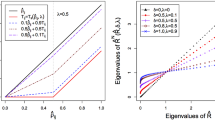Abstract
Indefinite symmetric matrices that are estimates of positive-definite population matrices occur in a variety of contexts such as correlation matrices computed from pairwise present missing data and multinormal based methods for discretized variables. This note describes a methodology for scaling selected off-diagonal rows and columns of such a matrix to achieve positive definiteness. As a contrast to recently developed ridge procedures, the proposed method does not need variables to contain measurement errors. When minimum trace factor analysis is used to implement the theory, only correlations that are associated with Heywood cases are shrunk.
Similar content being viewed by others
References
Bentler, P.M. (1972). A lower bound method for the dimension-free measurement of internal consistency. Social Science Research, 1, 343–357.
Bentler, P.M., & Tanaka, J.S. (1983). Problems with EM algorithms for ML factor analysis. Psychometrika, 48, 247–251.
Bonett, D.G., & Price, R.M. (2005). Inferential methods for the tetrachoric correlation coefficient. Journal of Educational and Behavioral Statistics, 30, 213–225.
Della Riccia, G., & Shapiro, A. (1982). Minimum rank and minimum trace of covariance matrices. Psychometrika, 47, 443–448.
Hoerl, A.E., & Kennard, R.W. (1970). Ridge regression: biased estimation for nonorthogonal problems. Technometrics, 12, 55–67.
Jamshidian, M., & Bentler, P.M. (1998). A quasi-Newton method for minimum trace factor analysis. Journal of Statistical Computation and Simulation, 62, 73–89.
Knol, D.L., & ten Berge, J.M.F. (1989). Least squares approximation of an improper correlation matrix by a proper one. Psychometrika, 54, 53–61.
Lee, S.-Y., Poon, W.-Y., & Bentler, P.M. (1995). A two-stage estimation of structural equation models with continuous and polytomous variables. British Journal of Mathematical and Statistical Psychology, 48, 339–358.
Wothke, W. (1993). Nonpositive definite matrices in structural modeling. In Bollen, K.A., & Long, J.S. (Eds.) Testing structural equation models (pp. 256–293). Newbury Park: Sage.
Yuan, K.-H., & Chan, W. (2008). Structural equation modeling with near singular covariance matrices. Computational Statistics & Data Analysis, 52, 4842–4858.
Yuan, K.-H., Wu, R., & Bentler, P.M. (2010). Ridge structural equation modeling with correlation matrices for ordinal and continuous data. British Journal of Mathematical and Statistical Psychology.
Author information
Authors and Affiliations
Corresponding author
Additional information
This research was supported by grants DA00017 and DA01070 from the National Institute on Drug Abuse. The first author acknowledges a financial interest in EQS and its distributor, Multivariate Software.
Rights and permissions
About this article
Cite this article
Bentler, P.M., Yuan, KH. Positive Definiteness via Off-diagonal Scaling of a Symmetric Indefinite Matrix. Psychometrika 76, 119–123 (2011). https://doi.org/10.1007/s11336-010-9191-3
Received:
Revised:
Published:
Issue Date:
DOI: https://doi.org/10.1007/s11336-010-9191-3



